Table of Content
This may not be very helpful, but for us the share itself is set up with only administrator access (e.g. user$) and then each user has access to only their own home folder. Typically for us though, if a senior manager needs a user's folder, it is infrequent enough that I simply set up their access to it manually. All other files they place on a shared resource for other managers to use as well. Remote repositories can be seen and reached via two different URLs – the repository-name and the repository-name-cache. The latter functions just like a local repository in that it only serves those files that are present in it. You cannot deploy artifacts directly to a remote repository cache.

User groups should only be used to group together staff members that are part of the same organizational unit . You want to make sure the folder that HOLDS the user folders, is set so everyone can read for this folder only. Then the user folders within said folder are where you're going to have to assign the specific permissions. So you'd want to set it so john_smith has permission over the john_smith user folder . Our folders/files already exist on a server and I am moving to a new server and want to set permissions correctly. Great responses and the server software makes it fairly easy to get this done.
How to Set NTFS Permissions Correctly
She is also a book lover, cineaste and passionate collector of curiosities. I've managed something like this before but its been quite some time. I'd like to avoid having the helpdesk perform so many manual steps that inevitably go afoul.

I have not been able to find a way to have a user able to access just their folder in the Home Folders, without being able to access everyones. For example, if a user needs to read information in a folder, and should never delete or create files, assign only the “Read” permission. These structures become especially confusing when permission groups are nested within themselves or within other permission groups by mistake.
Best Practices for Using Permissions
When pulling new files from a remote repository’s URL into a remote-cache, the user performing this request must have deploy/cache permission. Do not set explicit NTFS permissions on deep levels in the directory. Limit the number of levels to 2-3 in order to keep things clear and simple. The number of permission groups and list groups needed to manage explicit permissions on deeper levels quickly grows out of control.
This process should be avoided because it makes it more difficult to read NTFS permissions and, as a result, permission structures become confusing and chaotic. Users who have Read and Execute access to a specific folder must also have the List Folder Contents permission for any higher-up folders in order to navigate to their target. The List Folder Contents permission should be assigned via group membership. By using nested groups, you can ensure that each user automatically receives the NTFS permissions for browsing when they are given the relevant permissions to the subordinate folder.
Best practice for home folders?
Since Windows actually puts a hard limit on the number of groups a user can be part of, having too many nested groups can lead to not all permissions being read correctly. Otherwise, users end up being able to browse all directories on the file server. To avoid these kinds of mistakes in the future, read our free white paper and learn about best practices for managing permissions in Microsoft environments. The use of NTFS permissions does not automatically guarantee that users who have permissions for a specific folder can actually navigate to that folder via the Windows Explorer. This requires list permissions (“Show folder contents”) for superordinate directories. The number 1 mistake admins make when setting NTFS permissions is giving users direct access instead of assigning permissions through groups .

Try to discover patterns common to your users and/or projects. You'll generally find that your users have roles within your team that will define the type and variety of permissions they need. Using intuitive share names allow users to easily recognize and locate resources. For example, for the Application folder, use “Apps” as the share name.
Howto block personal devices on corporate network
You'd also need to consider what happens when people's managers change, so maybe create a function that could create folders if they don't exist, or simply fix up permissions if they do. We have a similar setup as Dave Murray for the users home drive. I do not share the user folder and only the user, system, and administrators have access. When we have users that quit, retire, or are fired I zip up the folder and archive it to another location. If someone such as the manager asks for access to the files I provide them a copy of the zip file.
This prevents users from seeing any other home folder other than their own. If you let users, even executives or managers, create new folders in the root directory, your tidy folder structure will soon become cluttered with random items. Instead, keep the root-level hierarchy locked down and only allow IT to add new directories.
When you assign permissions for working with application folders, assign the “Read & Execute” permission to the Users group and Administrators group. It’s a good practice to give “everyone” full control privileges on the Share Permission and then define specific permissions on the NTFS level—just as Microsoft has recommended it. Today, we are going to take a look atfive common mistakesmade when setting NTFS permissions. To help you avoid errors like these, we will also walk you through thebest practices for NTFS permission management. I got it working where newly created folders generated from AD when creating a new user, but there is a bunch of already existing folders that would need to to work the same way.
In a complex environment, however, over-privileging can happen especially when users belong to multiple groups, causing users to have access they shouldn’t have. Assign minimum permissions that allow users to perform the required tasks. Additionally, backups will also be less complex since you can choose which folders to backup without worrying if other file types will be included. So we’ve established what not to do when it comes to NTFS permissions, but how do you actually manage NTFS permissions correctly? There are various aspects to consider, but to help you get started, we’ve compiled the most important recommendations for managing NTFS permissions safely and efficiently. An in-depth manual on how to set up access structures correctly, including technical details.
Should you have a remote repository cache, Artifactory will first try to resolve your artifact from the remote-cache. If your artifact are not present in that location, Artifactory will then try to resolve your artifact from your remote registry. Permissions that are assigned to your remote repository will also apply to its remote-cache. This said, knowing the best way to assign permissions is not obvious. In particular, it’s helpful to get into the habit of setting up groups in which user roles and permissions for your teams/projects are carefully defined. To ease administration, it’s important to keep application files and data files on their own individual folders.

Also includes information on reporting and tips for implementation. You can learn more about how to securely manage Windows environments in our guide to Active Directory security. This will block the users from accessing other user home directories.
For instance, when using LDAP, you can import a group that a specific LDAP user belongs to and assign that group to Permission Targets. This will allow you to automatically grant your users specific permissions. In Windows, it is possible to “break up“ inheritance for permissions on each folder level. This means that the usual mechanisms (i.e. superordinate NTFS permissions are inherited by subordinate folders) can be bypassed, making it possible to set entirely new NTFS permissions.

Among other benefits, this will help save network share data in case of a Crypto-locker attack. We keep it simple and just have a redirect of their Documents and set the access to Exclusive. Only time we ever need to touch these folders is when an user leaves the company and at that time we seize ownership. Only ever set up 'home folders' on one or two small business sites, and found they were very seldom used. However, a few users had figured out that they were an ideal place to store porn or pirate stuff because even the admin couldn't see what was in there.

No comments:
Post a Comment